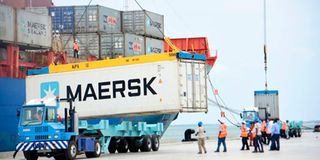Why security is a crucial ingredient of Lapsset project

Lamu Port begins operations after receiving its first Cargo Ship at Berth Number 1 during the official launch by President Uhuru Kenyatta in Lamu County on May 20, 2021.
Even as Kenya basks in the glory of putting the first berth of the new Lamu Port into operation, a bigger challenge, which could reverse the gains made so far, beckons. Alive to the security question, President Kenyatta recently urged the public to be vigilant and report criminal elements. The President also assured the local community, contractors, local and foreign investors, of their security.
There is no denying that security officers have a crucial role to play in complementing the government’s investment efforts, including keeping viable the new Lamu Port as well as the Sh2.5 trillion-worth regional Lamu Port-South Sudan-Ethiopia Transport Corridor project (Lapsset), which was launched in 2012.
Ideally, the security aspect has been of key interest to the security organs throughout the implementation phases of the Lapsset project, of which the Lamu Port is part. From the onset, there were fears that implementation of the Lapsset corridor would be delayed as a result of insecurity. This is after some of the contractors fled from the site following a series of attacks in Lamu County and its environs.
The Boni forest in Lamu, which serves as a hideout for Al-Shabaab, has equally proved a security headache, thanks to proximity to Somalia, where the terror gang is based.
Terror gangs
As President Kenyatta commissioned the 470-kilometre Lamu-Ijara-Garissa Road, of major interest is how to secure that stretch of the transport corridor to northern Kenya, and into South Sudan, which is frequented by terror gangs.
From boosting Kenya’s international trade, spurring infrastructural development, job openings, broadening regional trade and transport connectivity, the economic benefits of the Lamu Port and Lapsset projects cannot be overstated, which is why security hurdles must be overcome.
It is encouraging that President Kenyatta, who is the current Chairman of the East African Community (EAC), is promising to secure the business operations and projects of the regional bloc. And if he indeed gives meaning to his sentiments, the Lamu Port, for instance, which is a project envisioned under the government’s Vision 2030, is expected to host one of the biggest ports in Africa, further opening up economic space for the region as well as development.
Humanitarian engagements
Lapsset is destined to eventually connect northern Kenya to the Middle Belt of Africa, which runs from Dakar, Senegal in the west to Lamu in the east. Already, Kenya Defence Forces have beefed up security in Lamu where for the last seven years, they have made forays into Al-Shabaab hideouts in the Boni forest.
Other than combat missions, KDF has also employed a soft-power approach. The soldiers are getting involved in humanitarian engagements, including provision of medical, education and relief aid to the local communities.
A case in point is the airlifting of a woman who had been in labour for more than four days without access to medical attention. Her eventual delivery of twins at the King Fahad Hospital in November 2019 boosted relations between the locals and soldiers.
Lamu residents are now at the forefront in information sharing, with regard to criminal elements. Such cooperation should be extended to the Lapsset corridor. The public deserves a pat on the back for their collaboration with State agencies, despite the risks involved. It’s worth the risk because security is everybody’s responsibility.





